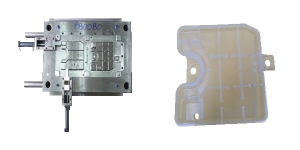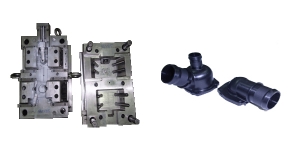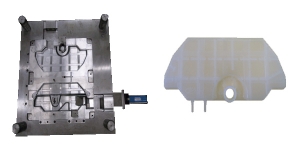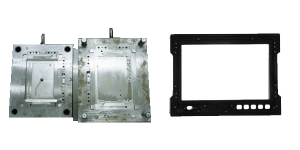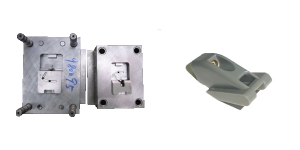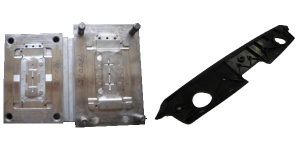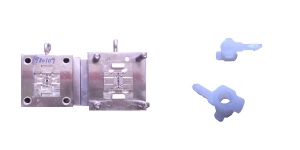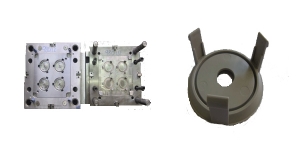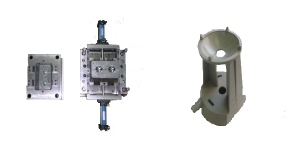In the field of metal work, various methods of casting are used to turn molten metals into specific shapes for use in commercial and industrial products. Within each casting process, a cavity is formed in which molten metal is poured either with gravity or high pressure. After a number of seconds have passed, the metal solidifies and the newly hardened casting is released from the mold or form.
Casting is most often employed to make intricate metal objects that would otherwise be complicated and much costlier to produce with different methods.
The process of casting has existed since ancient times. Some of the earliest examples of metal casting exist today in the form of jewelry, tools and sculptures that have been retrieved from archeological sites and put on display in museums around the world. Early methods of casting included plaster mold casting and lost wax casting.
Today, the methods of casting fall into the non-expendable and expendable categories. Other variants of the two categories include the methods used to fill cavities — including pressure and gravity — and the material used to form a particular mold.
First, there’s the non-expendable type of casting, which would account for any method in which the mold can be used again. Examples of non-expendable casting include permanent mold and die casting methods, in which the molding cavities are made of metal. Non-expendable casting is often favored for its ability to produce uniform parts at high volumes.
Expendable casting accounts for any method in which the mold is discarded after a single use. Examples in this category include sand and plaster casting, in which molten metal is poured into a cavity that is then broken away to reveal a finished casting. A further example of expendable casting is investment casting, a modern version of lost wax casting, in which molds are formed around wax patterns, which are then melted away to reveal hard ceramic cavities for subsequent metal molding.
Aluminum Die Casting
With aluminum die casting, a process takes place where molten metal is forced into a cavity in which a mold is formed. The process is achieved with a pair of steel dies that have been machined into particular shapes, which form the molding cavity when joined together. A similar process can also be applied with castings made of copper, magnesium and other metals.
The aluminum die casting process is divided into four stages: preparation, fill, ejection and trim off the gate.
First, a lubricant or die release agent is applied to each half of the cavity in preparation for the injection of the metal to be cast. Next, the dies are brought together and the cavity — in some cases one, in some cases two or more — is filled with molten metal under high pressure, which is maintained until the casting hardens.
A waiting period follows, after which the metal will have hardened into its final shape. With that step completed, the dies are separated and the castings are pushed out of the mold with ejector pins. Afterward, the parts that comprise the scrap — runners, sprues, overflows etc. — are trimmed away. In some cases, the finished shape will then receive sanding or polishing along the surfaces.
The high pressure at which the cavity is filled is crucial to the process because this prevents any part of the casting from hardening prematurely. This also ensures that the entire cavity is filled with no discontinuity, which could otherwise occur in die castings with complex shape formations. High pressure also eliminates the possibility of air bubbles, while the entrapment of air is further avoided with vents along the dies surfaces.
Aluminum die castings can also be produced with secondary features on molds, such as holes and grooves. Aluminum die casting is used to create everything from marine and sporting components to oil pumps, engine cradles, transmission transfer cases, heatsinks, enclosures, and brake components. The process is generally reserved for high-volume industrial productions.
Sand Casting
In the process known as sand casting, hardened casts of sand are used within a gating system to mold metals and other materials into shape. The sand is formed around patterns, which form cavities within the sand that are subsequently filled with molten metal. Due to sand’s heat-resistant quality, sand casting accounts for the vast majority of metal mold production.
To make the sand castings, sand is mixed with clay, water and sometimes other substances. The process here is a lot different than die casting because the hard sand that forms the mold is broken away and dispensed with afterward. Nonetheless, sand castings are often used to produce complex molds that are harder to make with die castings.
The process of sand casting is divided into several steps. First, a pattern is placed into the sand, where a cavity is then formed within the sand through the application of gating, after which the pattern is removed. In some cases, the cavity will be rather complex, with multiple grooves and several turns, twists and corridors.
Next, the cavity within the sand is filled at high pressure with molten metal. Once the metal has cooled into a hardened shape, the sand cast is broken away and the mold is removed. The finished mold might then be modified in whichever way is necessary, whether it needs to be trimmed or buffered to a smooth shine.
Sand casting molds are commonly used to make complex metal objects, such as one-piece equipment parts with various contours that would be hard to produce through other casting methods. Examples include the trap pipes used in household plumbing systems and metal doorknobs and lampshades.
Sand casting is also used for artistic items such as living room fixtures and metal sculptures. Sand casts are even used in jewelry production for items such as rings and metal bracelets. Whether the finished product is complex or simple, sand casting is a reliable method that allows manufacturers to form exact shapes with the utmost precision and detail.
V-Casting
An alternate form of sand casting is known as vacuum molding, or V-casting, which involves the use of unbonded sand. V-casting is often employed in the production of ferrous and non-ferrous metal molds.
The process makes it possible to form molds without the use of pressurized compaction methods, such as squeezing and blowing. Instead, clean molds are achieved with dry sand and vacuum pressure. V-casting allows manufacturers to do away with sand mixers and other equipment required for hardened sand.
V-casting can be carried out with a simple arsenal that consists of a vacuum system, a pattern, a film heater, a flask and a vibration surface. The process is generally clean and free of fumes or odors. Once finished, the dry sand is simply recycled for the next application. As such, V-casting is one of the most waste-free methods by which molds are cast for metal products.
In V-casting, patterns are placed onto boards with vacuum chamber vents. Heat-softened sheets of plastic are then placed over the pattern and the vacuums are activated. This causes the plastic to wrap tightly to the details of the pattern. Once hardened, the pattern is removed from the mold. Then, a vacuum process is utilized to pull molten aluminum through the cavities.
V-casting is often favored due to its ability to produce fine finishes with precise dimensions. A multitude of shapes can be achieved with the method, whether the mold is lightweight or heavy. The process allows you to reuse patterns multiple times and leaves little scrap excess material upon completion.
Investment Casting
Investment casting is a modern-day method of lost wax casting, which has been used for thousands of years in the creation of art fixtures, figures and masks. Archeological finds throughout Eurasia have included plates, vases and furnishings made with earlier forms of the wax casting method.
Investment casting is favored in a variety of industrial productions because of its versatility and accuracy of detail. Numerous mechanical pieces, such as valves and turbines, are made from the process of investment casting.
First, a master pattern is made from wax, or sometimes from wax replicas of a preexisting non-wax pattern. Next, a mold is created, which is also referred to as the “master die.” Several different wax patterns can be combined into a bigger pattern for a single molding. For industrial applications, the wax patterns are applied to a sprue that connects to a mechanical arm.
Next, the wax molds are dipped in ceramic with factory machinery. Then, the mold is heated and the wax melts out from the surrounding ceramic mold. With the ceramic molds now empty, molten metals are poured into the cavities formed by the ceramic.
Once the metal inside the ceramic molds have hardened, the ceramic forms are broken away. Afterward, excess parts are removed from the metal shapes, which are then readied for their ultimate use.
Where to Find Die Casting Manufacturer?
Champion H&C Inc. is a professional manufacturer of specializing in kinds of die casting processes and CNC machined products. Such as aluminum die casting parts, zinc alloy die casting parts, CNC lathe machining parts, CNC turning parts, and much more products that you all can find on Champion H&C website. If you need more information about die casting process, please do not hesitate to send inquiry to contact with Champion H&C Inc. immediately.
Article Source: https://diecasting.com/blog/2017/07/31/best-casting-process-for-your-needs/


